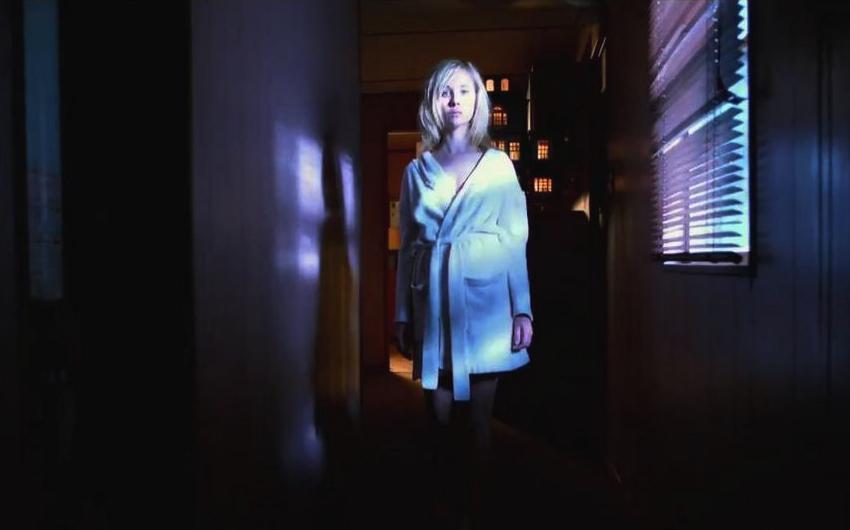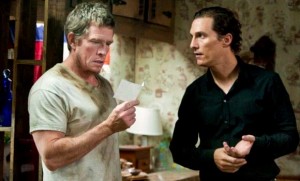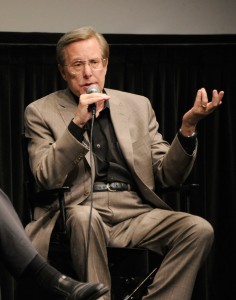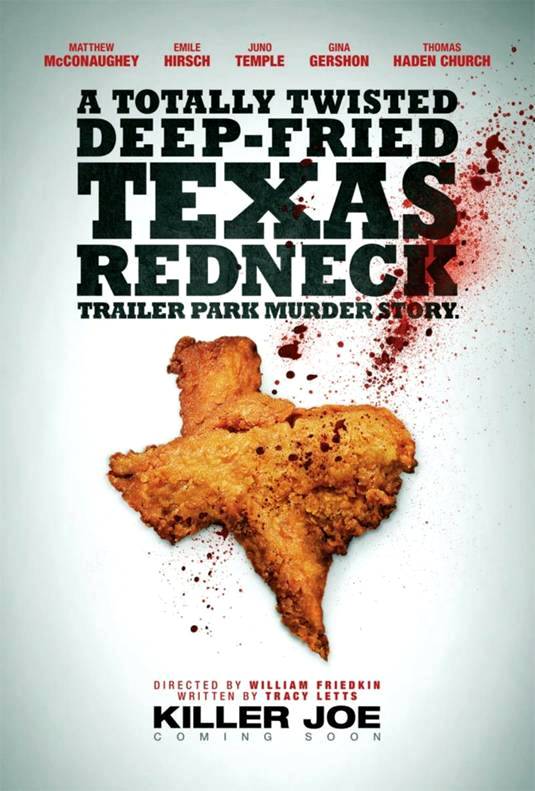
This NC-17 flick put me in a wicked, dark mood change. Killer Joe is a hired hitman tale set in the outreaches of the Dallas district, the grubbiness and depravity is established in a matter of shots. With this film, we are absorbed into a world of disgraceful, repugnant trailer trash people of extreme desperation. The film is the work of the controversial William Friedkin, an Oscar winner in 1971 for “The French Connection” and for the landmark horror masterpiece “The Exorcist” in 1973. His work as a director has seen some valleys, but with age he’s only getting stronger. He teamed with playwright Tracy Letts for “Bug” (2007) and now he teams with her again for this. The words in the script are gutter poetry, a mash of Cormac McCarthy and Charles Bukowski, or Quentin Tarantino and Tennessee Williams.
That was my opening a few weeks ago when I wrote it up immediately upon seeing it. Now this review is going through a brand new overhaul. The Aurora, Colorado tragedy happened nearly a week ago which took 12 lives and scarred 58 more. Now I’m wondering about “Killer Joe” from a more pointed inquiry. My primary question is: Where do these killers come from? The murder plot in Friedkin’s film is more conspiratorial, but it also derives from a place where there is a lack of empathy.
Father and son plan to have their mom murdered for the insurance policy money. The big plan is brought up by 22-year old Chris (Emile Hirsch), an incompetent drug dealer who owes a debt to a drug lord. Dad Ansel (Thomas Haden Church), has never seen $1,000 in his life, and so can’t bail his son out. He sees this plot’s advantages where he can also cash out. But Dallas Police Sheriff Joe (Matthew McConaughey, in his third great 2012 performance along with “Magic Mike” and “Bernie”), is a merciless contract killer who demands upfront payment. With no front fee in sight, he agrees to take Chris’ introverted sister as a “retainer.”
 Juno Temple, a young actress that I admittedly loathe, is perfect for once in the part as the dimwit Dottie, who goes up for equity in Joe’s arms and doesn’t have the insight that she is being used. Gina Gershon, as Sharla, is willing to get her lipstick smeared and mascara runs on her face for this part, and a whole lot more. She is the trickiest character to decipher on screen, only because we do not really know her depths until her final scenes.
Juno Temple, a young actress that I admittedly loathe, is perfect for once in the part as the dimwit Dottie, who goes up for equity in Joe’s arms and doesn’t have the insight that she is being used. Gina Gershon, as Sharla, is willing to get her lipstick smeared and mascara runs on her face for this part, and a whole lot more. She is the trickiest character to decipher on screen, only because we do not really know her depths until her final scenes.
I won’t deny that there is a misleading device employed so the film’s whopping plot twist hoodwinks us, but alas, I loved the explanation behind the plot twist. Visually, this is Friedkin at his most lurid. Without anything “scandalous” on-screen, he can manage in the simplest shots to convey sleaze and muckiness of which these characters inhabit. And after a century of movies where actors run for their lives and never run out of breath, Friedkin has found a way to fix the cliché.
You watch these people with nothing in their lives – they are the invisible spectrum of society who contribute nothing, because they are not needed. They are the people with no daily positive stimulation, nothing to reach for, stationed with pitiful destination goals. Depravity is easy, moral desolation is permeate as well as inevitable.
It takes more sophistication to understand the psychology underneath the characters in “Killer Joe” than it takes to comprehend an Oscar darling like “The King’s Speech.” These are dumb people that think they’re smart and savvy, although really they’re just in a deviant bubble. The most shocking sequence is a man forcing a woman to simulate fellatio on a fat drumstick, and if that’s a turn-off… you’d be all the more repulsed if I went on lavishly with the rest of the scene’s description.
Ruling the last quarter of the film is McConaughey with cruel, but cool, psychopathic control. Most of the twenty minutes are of McConaughey’s bravura mastery of dialogue, as well as physical imposition as he takes a family hostage. Yet the finest  performance, in a movie full of them, might well be the most natural – Thomas Hayden Church of “Sideways,” who always has one good muster of malicious wisdom followed by clueless back-up plans. He’s the one stupid character aware that he’s stupid. He is one very sad human being, ready to comply to violence only because he does not know to counter force with something thoughtful.
performance, in a movie full of them, might well be the most natural – Thomas Hayden Church of “Sideways,” who always has one good muster of malicious wisdom followed by clueless back-up plans. He’s the one stupid character aware that he’s stupid. He is one very sad human being, ready to comply to violence only because he does not know to counter force with something thoughtful.
The movie affected me, in a way that “Bad Lieutenant” (1992) or “Requiem for a Dream” (2000) did the first time. Friedkin has self-knowingly narrowed his commercial prospects with his film. But the NC-17 freedom is reason to rejoice. This kind of dark social commentary and subversive material – and the opportunity to get close up with the kind of venal and ghetto people you would fear to be standing next to in real life – is not something you would find in an entertainment geared for mass consumption. Only in Friedkin land, and in the NC-17 edict, can a movie like “Killer Joe” be found. This is your exclusive opportunity for your intelligent adult mind to get closer to people you are removed from. This is an art film that raises consciousness of where violent desperation breeds.
103 Minutes. Rated NC-17.
CRIME STORY / ADULTS ONLY / FRIDAY NIGHT WEIRD
Film Cousins: “The Onion Field” (1979); “Red Rock West” (1994); “Bug” (2007); “Animal Kingdom” (2010, Australia).






